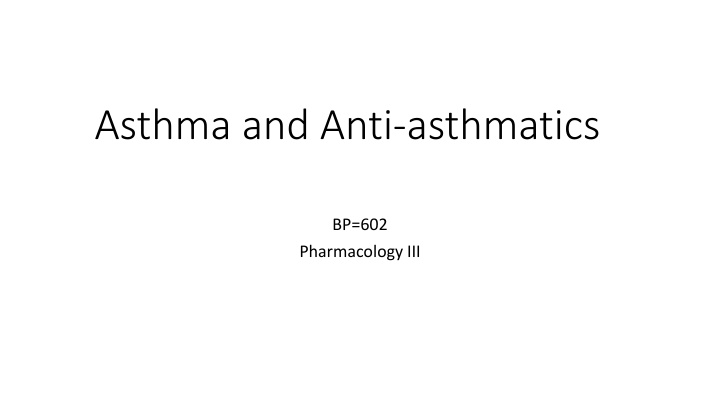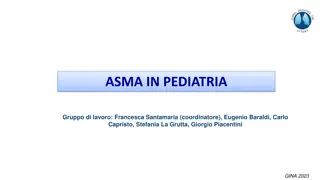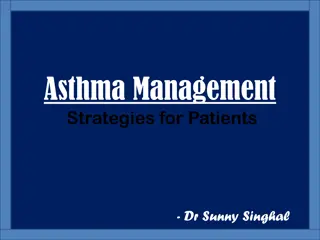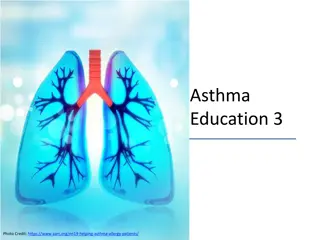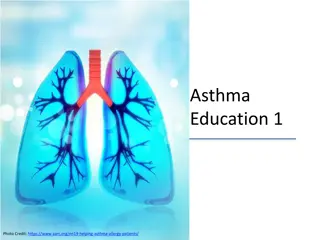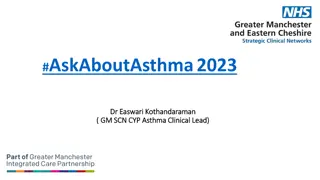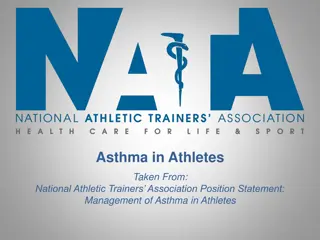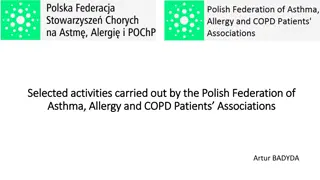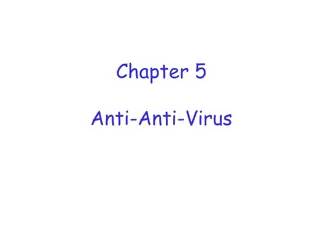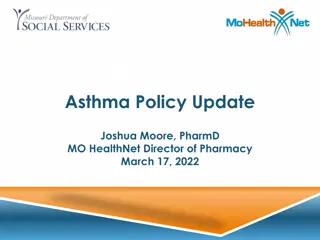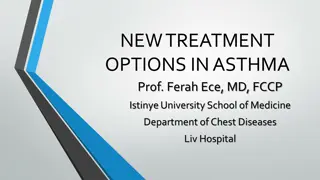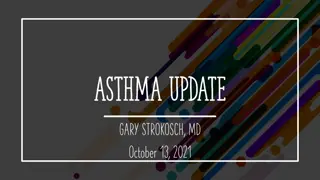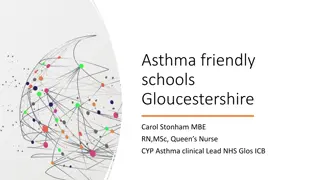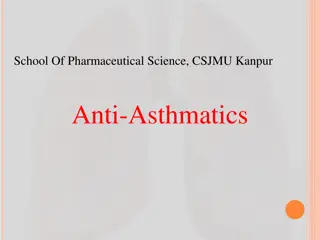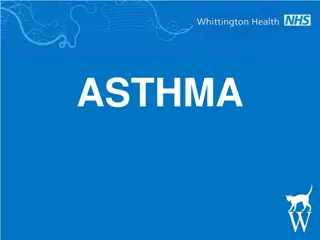Asthma and Anti-Asthmatics
Asthma is a respiratory disorder characterized by wheezing and breathing difficulties. Learn about bronchial asthma, anti-asthmatic drugs like bronchodilators, anticholinergics, leukotriene modifiers, mast cell stabilizers, and glucocorticoids used in treatment. Explore their mechanisms of action and side effects to better manage asthma symptoms.
Download Presentation

Please find below an Image/Link to download the presentation.
The content on the website is provided AS IS for your information and personal use only. It may not be sold, licensed, or shared on other websites without obtaining consent from the author.If you encounter any issues during the download, it is possible that the publisher has removed the file from their server.
You are allowed to download the files provided on this website for personal or commercial use, subject to the condition that they are used lawfully. All files are the property of their respective owners.
The content on the website is provided AS IS for your information and personal use only. It may not be sold, licensed, or shared on other websites without obtaining consent from the author.
E N D
Presentation Transcript
Asthma and Anti-asthmatics BP=602 Pharmacology III
Asthma Bronchial asthma is a respiratory disorder characterized by wheezing and difficulty in breathing due to increased resistance to airflow in the alveoli or small airways. This is caused by the spasm of the bronchial smooth muscles and also due to edema and swelling of bronchial mucous membrane. The viscid sputum causes blockage of small airways
Anti-asthmatic Drugs Drugs for the treatment of asthma are- 1. Bronchodilators a) B2 agonists These drugs produces bronchodilation through B2-receptors stimulation. Stimulation of these receptors increases Camp formation in bronchial muscle cell and produce relaxation .In addition increased cAMP in mast cells and other inflammatory cells decrease mediators release. There are two categories of B2 agonists i. Short acting- Orciprenaline, salbutamol, terbutaline, bitolterol procaterol pirbuterol etc These drugs are given by inhalation reale rather than the oral route. However, terbutaline, orciprenaline etc.are also available as tablets , Oral route is not encouraged because the systemic effects are persistent, Inhalation route produce minimal side effects. i. Long acting: Salmeterol and formoterol are long acting drugs and the effects last for about 12 hours Theophylline - The exact mechanism of action of theophylline is not known. The proposed mechanisms are a) Inhibition of phosphodiesterases: Phosphodiesterases which degrades cyclic nucleotides intracellularly are blocked by theophylline Bronchodilation occur due increased cAMP b) Blockade of adenosine receptors: Theophylline combines with the adenosine receptors and blocks it reg bronchodilation
Anticholinergies -Anticholinergic drugs cause bronchodilation by blocking cholinergic constrictor tone and bronchial secretion. They are less efficacious than B2agonists, but can add to their response. Atropine produces many side effects including dryness of mouth, hypotension, hallucination photophobia, urinary retention etc. Atropine also damages the cilia: therefore the use of atropine in the treatment of asthma is discontinued. However, ipratropium is almost free from side effects and does not produce cilliary damage, it is also not absorbed from GIT and therefore has to be given by inhalation route 2. Leukotriene modifiers - The cysteinyl leukotrienes (LT-C4/D4/E4 ) are important mediators of bronchial asthma. Two cysteinyl leukotrienes receptor antagonist (montelukast, zafirlekast), and 5-LOX inhibitors (zileuton) are recently available. The plane montelukast is 3-6 hrs, while that of zafirlukast is 8-12 hrs. Dose-10 mg OD
3. Mast cell stabilizers -Sodium cromoglycate, Ketotofen These drugs inhibit degranulation of mast cell by triggering stimuli. Release of mediator of asthma like histamine. LTs, PAF,. interleukins etc from mast cell as well as other inflammatory cell is prevented. Sodium chromoglycate is mast cell stabiliser, insoluble in water and is given as arresol. It is a prophylactic drug and has no bronchodilator action Dose: Sodium chromoglycate is administered as an aerosol 1 mg per dose 2 puffs 4 times a day. It is rapidly excreted unchanged in urine and bile. Its chief use is in the athma childhood, also used in allergic rhinitis 4. Glucocorticoids - Glucocorticoids like beclomethasone, flunisolide, triamcinolone, fluticasone and budesonide me given by inhalation and act to decrease the inflammatory process in the airways. In addition, the corticosteroids increase the sensitif D-receptors. With increased semivity of the receptors, the b-receptor agonist drugs become more effective. The glucocorticoids are contraindicated in patients with hypersensitivity to the corticosteroids, acute bronchospasm, status asthmatics or other cut of asthma. These are used cautiously in patients with compromised immune systems, glaucoma, kidney or liver disease. Convulsive disorders, or diabetes, thene taking systemic corticosteroids and during pregnancy
